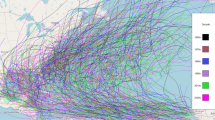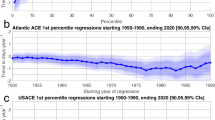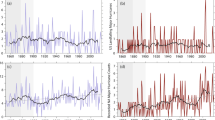Abstract
Because a change in the frequency (number/year) of hurricanes could be a result of climate change, we analyzed the historical record of Atlantic basin and US landfalling hurricanes, as well as US continental accumulated cyclone energy to evaluate issues related to trend detection. Hurricane and major hurricane landfall counts exhibited no significant overall trend over 167 years of available data, nor did accumulated cyclone energy over the continental USA over 119 years of available data, although shorter-term trends were evident in all three datasets. Given the χ2 distribution evinced by hurricane and major hurricane counts, we generated synthetic series to test the effect of segment length, demonstrating that shorter series were increasingly likely to exhibit spurious trends. Compared to synthetic data with the same mean, the historical all-storm data were more likely to exhibit short-term trends, providing some evidence for long-term persistence at timescales below 10 years. Because this might be due to known climate modes, we examined the relationship between the Atlantic multidecadal oscillation (AMO) and hurricane frequency in light of these short-term excursions. We found that while ratios of hurricane counts with AMO phase matched expectations, statistical tests were less clear due to noise. Over a period of 167 years, we found that an upward trend of roughly 0.7/century is sufficient to be detectable with 80% confidence over the range from 1 to 21 storms/year. Storm energy data 1900–2018 over land were also analyzed. The trend was again zero. The pattern of spurious trends for short segments was again found. Results for AMO periods were similar to count data. Atlantic basin all storms and major storms (1950–2018) did not exhibit any trend over the whole period or after 1990. Major storms 1950–1989 exhibited a significant downward trend. All-storm basin scale storms exhibited short-term trends matching those expected from a Poisson process. A new test for Poisson series was developed based on the 95% distribution of slopes for simulated data across a range of series lengths. Because short data series are inherently likely to yield spurious trends, care is needed when interpreting hurricane trend data.








Similar content being viewed by others
Explore related subjects
Discover the latest articles and news from researchers in related subjects, suggested using machine learning.References
Bender MA, Knutson TR, Tuleya RE, Sirutis JJ, Vecchi GA, Garner ST, Held IM (2010) Modeled impact of anthropogenic warming on the frequency of intense Atlantic hurricanes. Science 327:454–458
Coxe S, West SG, Aiken LS (2009) The analysis of count data: a gentle introduction to Poisson regression and its alternatives. J Pers Assess 91:121–136. https://doi.org/10.1080/00223890802634175
Curry J (2008) Potential increased hurricane activity in a greenhouse warmed world. In: MacCracken MC, Moore F, Topping JC (eds) Sudden and disruptive climate change: exploring the real risks and how we can avoid them. Earthscan, London, pp 29–37
Elsner JB, Bossak BH (2001) Bayesian analysis of U.S. hurricane climate. J Clim 14:4341–4350. https://doi.org/10.1175/1520-0442(2001)014<4341:baoush>2.0.co;2
Elsner JB, Schmertmann CP (1993) Improving extended-range seasonal predictions of intense Atlantic hurricane activity. Weather Forecast 8:345–351. https://doi.org/10.1175/1520-0434(1993)008<0345:ierspo>2.0.co;2
Elsner JB, Jagger T, Niu X-F (2000) Changes in the rates of North Atlantic major hurricane activity during the 20th Century. Geophys Res Lett 27:1743–1746. https://doi.org/10.1029/2000gl011453
Elsner JB, Bossak BH, Niu X-F (2001) Secular changes to the ENSO-U.S. hurricane relationship. Geophys Res Lett 28:4123–4126. https://doi.org/10.1029/2001gl013669
Emanuel KA (1987) The dependence of hurricane intensity on climate. Nature 326:483–485
Emanuel KA (2005) Increasing destructiveness of tropical cyclones over the past 30 years. Nature 436:686–688. https://doi.org/10.1038/nature03906
Goldenberg SB, Landsea CW, Mestas-Nuñez AM, Gray WM (2001) The recent increase in Atlantic hurricane activity: causes and implications. Science 293:474–479. https://doi.org/10.1126/science.1060040
Hall T, Hereid K (2015) The frequency and duration of U.S. hurricane droughts. Geophys Res Lett 42:3482–3485. https://doi.org/10.1002/2015gl063652
Hoyos CD, Agudelo PA, Webster PJ, Curry JA (2006) Deconvolution of the factors contributing to the increase in global hurricane intensity. Science 312:94–97. https://doi.org/10.1126/science.1123560
Klotzbach PJ (2006) Trends in global tropical cyclone activity over the past twenty years (1986–2005). Geophys Res Lett 33:L10805. https://doi.org/10.1029/2006gl025881
Klotzbach PJ (2010) On the Madden-Julian oscillation-Atlantic hurricane relationship. J Climate 23:282–293. https://doi.org/10.1175/2009jcli2978.1
Klotzbach PJ, Gray WM (2006) Causes of the unusually destructive 2004 Atlantic basin hurricane season. Bull Am Meteor Soc 87:1325–1334. https://doi.org/10.1175/BAMS-87-10-1325
Klotzbach PJ, Gray WM (2008) Multidecadal variability in North Atlantic tropical cyclone activity. J Clim 21:3929–3935. https://doi.org/10.1175/2008JCLI2162.1
Klotzbach PJ, Landsea CW (2015) Extremely intense hurricanes: revisiting Webster et al. (2005) after 10 years. J Clim 28:7621–7629
Klotzbach PJ, Bowen SG, Pielke R, Bell M (2018) Continental US hurricane landfall frequency and associated damage. Am Met Soc. https://doi.org/10.1175/BAMS-D-17-0184.1
Knapp KR, Kruk MC, Levinson DH, Diamond HJ, Neumann CJ (2010) The International Best Track Archive for Climate Stewardship (IBTrACS): unifying tropical cyclone best track data. Bull Am Meteor Soc 91:363–376
Knutson TR, Tuleya RE (2004) Impact of CO2-induced warming on simulated hurricane intensity and precipitation: sensitivity to the choice of climate model and convective parameterization. J Clim 17:3477–3495. https://doi.org/10.1175/1520-0442(2004)017<3477:iocwos>2.0.co;2
Knutson TR, Sirutis JJ, Garner ST, Held IM, Tuleya RE (2007) Simulation of the recent multidecadal increase of Atlantic hurricane activity using an 18-km-grid regional model. Bull Am Meteor Soc 88:1549–1565. https://doi.org/10.1175/bams-88-10-1549
Knutson TR, Sirutis JJ, Garner ST, Vecchi GA, Held IM (2008) Simulated reduction in Atlantic hurricane frequency under twenty-first-century warming conditions. Nat Geosci 1:359–364. https://doi.org/10.1038/ngeo202
Knutson T, Camargo SJ, Chan JCI, Emmanuel K, Ho C-H, Kossin J, Mohapatra M, Satoh M, Sugi M, Walsh K, Wu L (2019a) Tropical cyclones and climate change assessment: part I. Detection and attribution. Bull Am Met Soc 100(10):1987–2007
Knutson T, Camargo SJ, Chan JCI, Emmanuel K, Ho C-H, Kossin J, Mohapatra M, Satoh M, Sugi M, Walsh K, Wu L (2019b) Tropical cyclones and climate change assessment: part II projected response to anthropogenic warming. Bull Am Met Soc. https://doi.org/10.1175/BAMS-D-18-0194.1
Kossin JP (2017) Hurricane intensification along United States coast suppressed during active hurricane periods. Nature 541:390–393
Kossin JP, Knapp KR, Vimont DJ, Murnane RJ, Harper BA (2007) A globally consistent reanalysis of hurricane variability and trends. Geophys Res Lett 34:L04815. https://doi.org/10.1029/2006gl028836
Kossin JP, Olander TL, Knapp KR (2013) Trend analysis with a new global record of tropical cyclone intensity. J Clim 26:9960–9976
Koutsoyiannis D (2013) Hydrology and change. Hydrol Sci J 58:1177–1197. https://doi.org/10.1080/02626667.2013.801626
Kunke KE, Karl TR, Brooks H, Kossin J, Lawrimore JH, Arndt D, Bosart L, Changnon D, Cutter SL, Doesken N, Emanuel K, Groisman PY, Katz RW, Knutson T, O’Brien J, Paciorek CJ, Peterson TC, Redmond K, Robinson D, Trapp J, Vose R, Weaver S, Wehner M, Wolter K, Wuebbles D (2013) Monitoring and understanding trends in extreme storms. Bull Am Meteorol Soc 94:499–514. https://doi.org/10.1175/BAMS-D-11-00262.1
Landsea CW (2015) Comments on “Monitoring and understanding trends in extreme storms: state of knowledge”. Bull Am Meteorol Soc 96:1175–1176. https://doi.org/10.1175/BAMS-D-13-00211.1
Landsea CW, Franklin JL (2013) Atlantic hurricane database uncertainty and presentation of a new database format. Mon Weather Rev 141:3576–3592. https://doi.org/10.1175/mwr-d-12-00254.1
Landsea CW, Nicholls N, Gray WM, Avila LA (1996) Downward trends in the frequency of intense Atlantic hurricanes during the past five decades. Geophys Res Lett 23:1697–1700. https://doi.org/10.1029/96gl01029
Landsea CW, Pielke RA Jr, Mestas-Nuñez AM, Knaff JA (1999) Atlantic basin hurricanes: indices of climatic changes. Clim Change 42:89–129. https://doi.org/10.1023/a:1005416332322
Landsea CW, Harper BA, Hoarau K, Knaff JA (2006) Can we detect trends in extreme tropical cyclones? Science 313:452–454. https://doi.org/10.1126/science.1128448
Moon I-J, Kim S-H, Chan JCL (2019) Climate change and tropical cyclone trend. Nature. https://doi.org/10.1038/s41586-019-1222-3
Nyberg J, Malmgren BA, Winter A, Jury MR, Kilbourne KH, Quinn TM (1980s) Low Atlantic hurricane activity in the 1970s and 1980s compared to the past 270 years. Nature 447:698–701. https://doi.org/10.1038/nature05895
Pielke RA Jr, Gratz J, Landsea CW, Collins D, Saunders MA, Musulin R (2008) Normalized hurricane damage in the United States: 1900–2005. Nat Haz Rev 9:29–42. https://doi.org/10.1061/(asce)1527-6988(2008)9:1(29)
Saunders MA, Lea AS (2008) Large contribution of sea surface warming to recent increase in Atlantic hurricane activity. Nature 451:557–560. https://doi.org/10.1038/nature06422
Solow AR, Moore LJ (2002) Testing for trend in North Atlantic hurricane activity, 1900–98. J Climate 15:3111–3114. https://doi.org/10.1175/1520-0442(2002)015<3111:tftina>2.0.co;2
Staehling EM, Truchelut RE (2016) Diagnosing United States hurricane landfall risk: an alternative to count-based methodologies. Geophys Res Lett 43:8798–8805. https://doi.org/10.1002/2016gl070117
Trenary L, DelSole T, Camargo SJ, Tippett MK (2019) Are midtwentieth century forced changes in North Atlantic hurricane potential intensity detectable? Geophys Res Lett 46:3378–3386. https://doi.org/10.1029/2018gl081725
Truchelut RE, Hart RE (2011) Quantifying the possible existence of undocumented Atlantic warm-core cyclones in NOAA/CIRES 20th Century reanalysis data. Geophys Res Lett. https://doi.org/10.1029/2011GL046756
Truchelut RE, Staehling EM (2017) An energetic perspective on United States tropical cyclone landfall droughts. Geophys Res Lett 44:12013–12019. https://doi.org/10.1002/2017gl076071
Vecchi GA, Knutson TR (2011) Estimating annual numbers of Atlantic hurricanes missing from the HURDAT database (1978–1965) using ship track density. J Clim 24:1736–1746
Webster PJ, Holland GJ, Curry JA, Chang H-R (2005) Changes in tropical cyclone number, duration, and intensity in a warming environment. Science 309:1844–1846. https://doi.org/10.1126/science.1116448
Webster PJ, Curry JA, Liu J, Holland GJ (1713c) Response to comment on “Changes in tropical cyclone number, duration, and intensity in a warming environment”. Science 311:1713c. https://doi.org/10.1126/science.1121564
Zhang W, Villarini G, Vecchi GA, Murakami H (2017) Impacts of the Pacific Meridional Mode on landfalling North Atlantic tropical cyclones. Clim Dyn 50:991–1006
Zhao M, Held IM (2012) TC-permitting GCM simulations of hurricane frequency response to sea surface temperature anomalies projected for the late-twenty-first century. J Clim 25:2995–3009. https://doi.org/10.1175/jcli-d-11-00313.1
Acknowledgements
No outside funding was used for this study.
Author information
Authors and Affiliations
Corresponding author
Ethics declarations
Conflict of interest
The authors declare that they have no conflict of interest.
Additional information
Publisher's Note
Springer Nature remains neutral with regard to jurisdictional claims in published maps and institutional affiliations.
Rights and permissions
About this article
Cite this article
Loehle, C., Staehling, E. Hurricane trend detection. Nat Hazards 104, 1345–1357 (2020). https://doi.org/10.1007/s11069-020-04219-x
Received:
Accepted:
Published:
Issue Date:
DOI: https://doi.org/10.1007/s11069-020-04219-x




